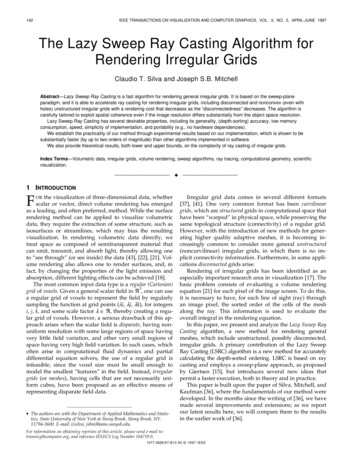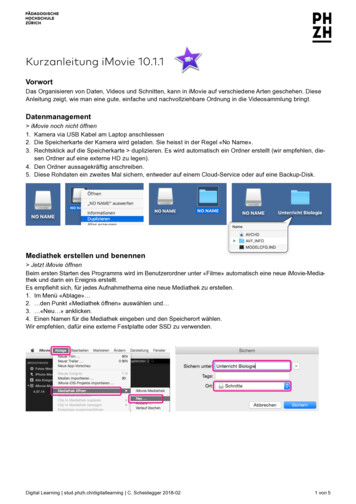
Transcription
A Lazy Man’s Guide to Stained GlassProfessional tips, tricks, and shortcuts3rd Editionby Dennis BradyPublished by:DeBrady Glass Studios566 David St.Victoria, B.C. V8T 2C8CanadaTele: (250) 382-9554Email: info@glasscampus.comWebsite: www.glasscampus.comAll rights reserved. No part of this publication may be reproduced or transmitted in any form or byany means, electronic or mechanical, including photocopy, recording, or any information storagesystem, without permission in writing from the author, except by a reviewer who may quote briefpassages in a critical article or review.Copyright 2002 by Dennis BradyPrinted in Canada
This book is dedicated to my son Brant.He introduced me to stained glass and helped me startDeBrady Glass Studios.It’s unfortunate he couldn’t stay long enough to see what it became.
RecognitionCovers and Illustrations by:Lar de Souza4 Division StreetActon, Ontario L7J 1C3CANADATele: (519) 853-5819Fax: (519) 853-1624Email: lar@lartist.comWebsite: http://www.lartist.com/Swag lamp and transom:Inspired by designs fromSomers-Tiffany Inc920 West Jericho TurnpikeSmithtown, NY 11787Tele: (631) 543-6660Email: sales@somerstiffany.comWebsite: http://www.somerstiffany.comPrairie table lamp:Inspired by a design by Dale Grundon305 Lancaster AveMt. Gretna, PA 17064Tele: (717) 964-2086Email: dalel@paonline.comWebsite: http://www.DaleGrundon.com
AcknowledgementSo many people helped me over the years that there wouldn’t bespace here to say thank you to all those it was due. Without theconsistent support of all of them, this lazy old guy would neverhave written this book. A sincerely heartfelt thanks is due toeveryone that contributed ideas, critique and encouragement –and steadily pressured me to finish and publish it.All those people I talked with at different glass shows and themany, many more with whom I exchanged ideas and opinions ondifferent internet stained glass forums supplied a lot of thequestions and comments that directed me to where I should gowith my writings. I hope I’ve been able to satisfactorily answer allof their questions with this book.A special note of gratitude should go to all those antagonistictroglodytes on the internet exchanges that so persistently attackeddissenting opinions from behind aliases and pseudonyms. Morethan anything else, it was their “My way is the only right way”attitudes, along with their “It must be done this way because it’salways been done this way”, that gave me the resolve anddetermination to see this book through to publication anddistribution.
ContentsIntroduction The Lazy Way 1The Easy Way 2Attitude . Assume Nothing . 3Fill Your Tool Box . 3What Kind of Experience? 4Amateur or Pro? . 4Good Enough? 4The Best Way to Learn . 5The Best Technique . 5Safety . Keep Sharp . 6Safety Glasses 6Flux Fumes . 7Lead Poisoning . 7Glass and Children . 8Dust . 8Tempered Glass . 8Designing . I Can’t Draw! 9Resizing Patterns 9Drawing with a Computer . 10Think Like an Engineer . 10Use the Lines . 11Color Selection . 11Know When to Stop . 11Composition 12K.I.S.S. Principle 12Drilling Glass . With a Grinder 13With a Drill . 13Wire . Wire sizes 14Straightening Wire . 14Stripping Wire . 15Fluxing . 15Tinning Wire 15Soldering Same Size Wires 15Soldering Different Size Wires . 16Soldering Wire onto Lead 16What if it Lets Go? . 16Use a “Heat Sink” .16What is the Best Temperature? .16
ContentsTools What’s the Best Tool? . 17Glass Saws 17Toolaholicalism . 18Metal-cutting Saws 18Cutting Glass Saws . 19Hand-held Cutters . 19Stationary Cutters . 19Pneumatic Cutters . 20Waterjet Cutters . 20Cutting Oil . 20Oil Advantage 20Clearing your Cutter . 20Damaged Cutter? . 21Storing Your Cutter 21Cutter Position 21Cutting Mirror . 21Cutting Methods . 22Lightbox . 22Running a Score 23Cutting Problems 24Cutting Stance 24Cutting out Arcs . 25Cutting a “V” . 25Practice . 25Cutting Multiples 26Cutting with a Saw . 26Grinding . Grinder Heads 27Grinder Coolant .27Finger Protection 28Belt Sanders 28Do it by Hand? 28Grinding Problems . 29Grozing The Old Fashioned Way . 30Foiling . Foiling Machines 31What Size Foil? . 31Foil or Lead? . 32Storing Foil . 32Fitting Foil Work 32Foiling Nuggets . 33Foiling Problems 33
ContentsLead . Why Stretch Lead? . 34How to Stretch Lead .34Why Not Stretch Lead? . 35Putty 35When to Putty? . 35Assembly Incrementalism . 36Fitting Foil 36Fitting Lead . 36Preparing to Solder . 36Flux . Applying Flux . 37Kinds of Flux .37What’s Best? . 38Flux Fumes . 38Soldering . Kinds of Solder . 39Lead-free Solder 39Soldering Iron Tips .39What Size Iron? . 40Temperature Control . 40Keep Your Tip Clean . 40Soldering Methods . 41Soldering Mirror 41Edge Beading . 41Electrical Tape . 42Filling Gaps 42Pre-beading 42Cleaning . 42Wearing Gloves . 42Soldering Problems . 43Patina . When to Patina? 44Applying Patina . 44Making Your Own Patina .44Waxing Patina . 45Neutralizing 45Black Patina 45Copper Patina . 45Stove Black . 46Gun-blue . 46Patina Problems .46
ContentsReinforcement Types of Reinforcing 47When to Reinforce . 48Installing . Thermal Shock . 49Multiple Glazing .49Expansion . 49Installing a Panel 50Repairs Bowed Windows .51Repairing Scratches . 51Foil Repair Methods . 51Lead Repair Problems . 52Handling . Transporting Glass .53Turning a Panel .53Packing to Ship . 54Teaching . Why Teach? . 55Selling . Selling Your Work . 56Commissions . 56Pricing for Sale . 57Craft Shows 57Consignment . 58Selling Wholesale . 59Websites .60Index . 61Biography 63Other Books . 64
IntroductionThis is not a “how to” book for beginners.There’s already lots of those. Instead, this isa “what’s next” book.It’s meantforsomeone that has already learned, or isworking on learning, the fundamentals ofstained glass work. Someone, perhaps likeyou, that’s wondering “where do I go next”,or “Is there an easier way?” If you’re toolazy to slog through all the dead-end tripsand all the error part of trial and error, this isthe book for you. I hope it helps.I wanted to put together a list of all theeasiest and best ways to do everything, butsuch a list might not be much help to you.What’s easiest and best for me, might notwork so well for you. What I’ve doneinstead is suggest the alternatives andsome of the advantages and disadvantagesof each.Instructors will usually teach their studentsthe method that is the easiest to learn. Thatmight not be the most efficient or easiestway to do something. More often, theeasiest way to do it is the way that takes thelongest to learn. You must decide foryourself how much time you’re willing tospend learning and practicing thesealternatives.Come on in. Sit down and we’ll talk.The Lazy WayI’m lazy - a special kind of lazy. I don’t mindworking long or working hard, but I seriouslyresent working any longer or any harderthan I have to. If there’s an easier way, orquicker way to do something, that’s mychoice.From the first day I startedcommercially producing stained glass, I’vebeen experimenting with quicker and easierways to do the job.Often the best shortcut is getting it right the firsttime.A lot of these experiments were outrageousfailures, but a few were a surprisingsuccess. I’d like to share some of thosewinners with you.1
Introductionclimbing up a ladder trying to carry a bigsheet of 1/8” glass and maneuvering it inplace? We are both experienced glassguys, but could not do it.The Easy WayHere’s a little story I’m passing on from J.K.Sinrod of Sinrod Studios in Lynbrook, N.Y.It’s now another week later, and thecustomer is getting testy wondering why it’snot finished. I’ve lost hours, nights, anddays of sleep over this. My buddy comesinto the shop and announces, “OK nextweek you, me, and my pal Chris and hishelper (a mirror and glass installer) will allmeet at 8 am with a series of 4 ladders andsetup a series of handoffs with the sheets‘till we get them up to the top”. As you canimagine, I don’t get too much sleep thatnight.It seems like I’m the only one that cansupply this big Temple with large enoughsheets of colored glass to go OVER existingwindow that are creating a lot of glare.They don’t want to remove the old ones,some of which are deep sandblasted. Ireally don’t care to do this, but before I knowit I get them samples of cathedral colors thatthey can fight over. (you know thesereligious committees – trying to agree onanything is a chore). I gave them anobscene price, and don’t you know, after 6months they call up and are raring to go. Igo through hell trying to get all this glass in72 x 60 sheets in the right colors, deliveredand cut up to fit. Most of the shapes arerectangles about 48 x 34 with a few oddballcurves and trapezoids to add to the trouble.I shoot ‘em in with points and caulking. I putin the first couple of rows by myself, andnow I’m at the end of my 12 foot A-frameladder. I simply cannot reach the 16’ height– much less the top ones over 20’ high.All four of us meet at 8 am the next day.Glass, ladders, suction cups, hoists,standoffs, gear that isn’t even in the CRLawrence catalog! Chris walks in – 5’8” tall,about 140 lbs. He takes a look and says“Two hours.” “Oh my God, not that,” I say.My buddy describes the plan of 4 guys, 4ladders, handing off, etc., etc. Chris says,“Just stand back and let me work”. He teststhe 20’ extension ladder, walks up the 1ststep and says, “hand me the biggest sheet”.He has soooo much confidence in hismanner that we all step away after doingwhat he asks. He kind of hefts the glass forsize and weight, puts it on his shoulder, theentire sheet of glass by himself, and climbsone handed to the top, carefully turns ifaround and plops it in place. Done! Mybuddy and I, who are bid guys, look at eachother in astounding amazement and roarwith laughter and embarassment.“Ofcourse, that’s the way to do it .it looks soeasy”. An hour and a half later all the 18sheets are in and completed.I spend the next few weeks investigatingscissor-jacks, lifts, scaffolds, cherry pickers.Trust me – none of these options will work,for many reasons. It’s indoors on a woodenstage, with a large unmoveable piece offurniture in the middle. What to do? I callmy closest “friendly” competitor and offer tohire him for the day to put these in with me.After explaining it all to him, and hearinghim call me a wimp, he agrees. We meetthe next week and he brings his 20’extension ladder and his burly machoattitude. He takes a look at the high, tall,wide window and says ”Two hours tops”.An hour later we simply cannot get ONEsheet of glass up high enough. Picture usSometimes the easiest way is also thesimplest. Nothing complicated, elaborate orfancy. Just do it.2
Attitudea quadzillion bits of glass into every crackand corner of my workshop.I’ve beenfinding these bits years later in the strangestplaces. But, other experiments producedinteresting results and huge time savings. Itried soldering at increasingly highertemperatures to see what happened. Theresult was a superior quality soldering job ina lot less time. I discovered that as Iincreased the heat, the solder got smootherand it became increasingly easier to solder.The “experts” insisted that you can’t cut acircle out of glass the way James Bond didit in the movies. I tried anyway. They wereright! It won’t work the way it’s done in themovies. But, my attempts taught me aquick and easy way to cut a circle (or othershapes) out from inside a piece of glass. Italso taught me a way to cut deep curvesthat worked better than the traditional seriesof fish scales.If you think you CAN do something, you’realready halfway done.The most important thing I learned was thatjust because a method worked well, doesn’tmean there isn’t another method that worksbetter. Never assume – always experiment.Try new things.Just don’t try cuttingtempered glass with a band saw. Trust meon this one.If you think you CAN”T, you’re completelyfinished.Assume NothingJust because some “expert” tells yousomething won’t work, don’t assume they’reright. It could be, and often is, that theexpert just never tried it. Don’t’ assume thatthe way you were first taught, is the “best”way until you have tried some other ways.There are no “best” ways – just personalpreferences. How can you decide whichway you prefer and feel most comfortablewith, until you have tried them all?Fill Your Tool BoxTools aren’t just things you buy at ahardware store.They’re also all thepersonal skills you learn from practice andexperimentation. Each new technique youlearn is another tool to add to yourcollection. No single tool works for everyjob, and no single skill is right for everyapplication. The more tools you have, themore likely it is you’ll have the one thatworks best for whatever you want to do.I’veexperimentedwithalotofunconventional ideas – and even somethoroughly weird ones. Many unexpectedthings not only worked, but workedextremely well. Even the experiments thatfailed, taught me something. My attempt tocut tempered glass with a band sawproduced a crystal explosion that scatteredTake the time to collect as many tools asyou can for your tool box. Learn everythingyou can so you’ll always have the right tool.3
AttitudeWhat Kind of Experience?poorly paid for their time. It’s not that eitherthe amateur or professional is superior tothe other, but that each has a different goal.The amateur might often produce betterwork, but takes so long it would beimpossible to make a living doing it. Theprofessional tries to produce work to a setstandard and work quickly enough toproduce it at a price customers are willing topay.There are two distinctly different kinds ofexperience. There’s the really good kindwhere you’re constantly learning new thingsat every opportunity, and using those newthings to add to all your previous experienceand knowledge. Then, there’s the not sogood kind where you learn a few things inyour first year or so, and keep on repeatingit over, and over, and over. What kind ofexperience do you have? Did you learn justthe basics and keep repeating it withouttrying new things and learning some newtechniques, or have you been constantlyimproving? Do you have ten years of thesame experience, or is it one year you’verepeated ten times? Are you saying, “I do itthis way because I’ve always done it thisway.” Or, is it, “Of all the ways I’ve tried, Ilike this one best”.The greatest difference between amateursand professionals is not in the quality oftheir work, but in how long it takes toproduce it.Good Enough?Because a professional must worry abouthow long it takes to produce something,they must have a clearly defined goal as towhat level of quality is required. It doesn’tneed to be perfect, but to be done to anacceptable professional standard.Theamateur doing it as a hobby will often chasean elusive goal of perfection. The problemwith trying for perfection, is that it’s anunreachable goal. No matter how good itwas done, it could have been better.Perfectionism can easily become acompulsive obsession.Amateur or Pro?There’s nothing wrong with being anamateur any more than there’s anythingwrong with being a professional. Each hasdifferent goals and each works in differentways. Some of the very best work is doneby amateurs that make stained glass as ahobby. They enjoy the luxury of time anduse it to good advantage. Amateurs don’tcare how long it takes to complete a project,but take pleasure in doing it. They have noreason to rush and can take however long isneeded. The result is often work that’ssuperior to that done by professionals.When you make something, you might askyourself, “Who am I trying to please?” If it’sfor yourself, you’ll probably never besatisfied with the quality and be foreverunable to overlook it’s imperfections. Mostof us have the same problem that wheneverwe look at our work, we see only the flawsand the “could have done betters”. If youmake something as a gift for a friend or forsale, the standard is different. It should betheir opinion, and not yours, that determinesacceptability.The pro expects to be paid for his or hertime, so must learn to work quickly. It’s thespeed at which they work that determineshow well they are paid. They know thatthere is a limit to what a customer is willingto pay. If they demand too high a price, thecustomer will refuse to buy it. If they taketoo long to produce that work, they’ll beIf they’re satisfied with it, it is good enough.4
AttitudeThe Best Way to LearnThe Best Technique?There’s no one best way to learn. Each ofus is unique and learns in uniquely differentways.Some of us learn by personalexperiments, while others prefer to watchothers demonstrate it. You might prefer apersonal structured lesson, while others dobetter working at their own pace with booksor videos. Many people have found theinternet to be a great learning source.A method or technique that works well foryou might not for someone else. Somethingthat is perfect for one application might beuseless for another. Each of us has fromour own practice and experimentationdiscovered the ones we are mostcomfortable using and when differentalternative methods are most effective. It’sfoolish to reject anything you’ve never tried.Sometimes the least expected method willsurprise you and end up becoming yourfavorite, or it may turn out to be the onlything that works right for that very specialthing you’re trying.For a long time I told people the secret tolearning was “Practice, practice, practice”.This is the single most important factor inlearning stained glass, but there is muchmore to it than that. Dale Grundon of DaleGrundon Stained Glass Designs, hassuggested a formula for learning that I thinkdescribes it well.In the end, the best method for you is theone that you best like using.Practice do glass read about glass techniques ask questions listen observe others experiment evaluate your own work work safe discuss glassDevotion Learning to do glassIf you spend all your time trying to do the verybest work, you’ll not have the time to finish a lotof satisfactorily good work. Best is the enemy ofgood!Maybe the best way to learn anything is tomake a commitment to never stop learning.Practice teaches you how to do somethingbetter. Experience teaches you how to makeless mistakes.Get the job done quick schemes don’t work anybetter than get rich quick schemes.5
SafetySafety GlassesI’m sure that by now you’ve been told towear safety glasses – probably severaltimes. Well, I’m going to tell you again.This is so important, it can not be stressedtoo many times. Dozens of times I’ve hadto rinse a glass bit out of someone’s eye, orwait in the Emergency ward for a doctor toextract it. It gave me a serious respect forhow easy it can happen - when someonethinks, “It’s just a quick cut, it’ll be okay.” or,“Just a quick grind to this one piece. I don’tneed the glasses.”You can buy expensive glasses, or cheapones – any kind is better than nothing aslong as you do wear them. Cheap safetyglasses work fine. They just won’t last aslong as the more expensive brands.Whatever kind you choose, it’s a smart ideato get ones that have a bottom that sitsagainst your cheek. When you break glassor grind it, shards can fly up, hit your checkjust under your glasses, bounce off theinside of the glasses, and go straight intoyour eye.This happens often whilegrinding, when the glass bits will betravelling fast enough to imbed firmly intoyour eye.Glass artisans don’t break for coffee.They break to congeal.I mentioned this was important didn’t I?Well, it’s so important, I think I’ll say it again.Keep SharpMost glass cuts result from not payingenough attention to what you’re doing.Unless you think wearing dozens of bandaides makes you look sophisticated, stayingalert is the smart way to handle glass.Razor sharp edges can slice like a scalpel,and thin slivered shards will impale like aspear. It’s important to always be aware ofthe potential for serious damage when youwork with glass.Complacency causesmore injuries than anything else. Keepyourself sharp – always pay attention towhat you’re doing.ALWAYS PROTECT YOUR EYES.Safety is a working attitude. Don’t just do it thebest way, do it the safe way.6
SafetyFlux FumesLead PoisoningIf there has been too much fear about leadpoisoning, there has been too little aboutthe potential damage from flux fumes.Vaporized flux is both poisonous andcorrosive. You know how irritating flux is onour skin. Imagine how bad it is inside yourlungs. You might think it’s enough to justuse a fan to blow the fumes away fromwhere you’re working. It isn’t! This justcirculates the fumes around the workplaceso you can inhale them later.Of course this is serious, but not near asmuch as has been publicized or as manypeople have come to believe. Fear of leadcontamination has been fueled with anirrational paranoia that is often unsupportedby scientific evidence.The myth continues to circulate that leadparticles will be absorbed through your skinwhile handling it, and that you will inhalevaporized lead while soldering. Both ofthese are unsubstantiated. Lead won’t gothrough the pores of your skin and solderingwon’t vaporize it into a form that can beinhaled. However, it is possible to get leadinto your blood through cuts or breaks in theskin. Covering these skin openings with aband-aide, or wearing gloves whilesoldering is enough to protect you.It’s important to remove flux fumes entirelyfrom where you work. Several small “fumetraps” are available that vacuum the fumesand send them through a filter. To somevarying degrees they all work.Aninexpensive and more effective protection isto extract the fumes entirely with aventilation system. This can be as simpleas a cheap kitchen range hood over yourwork table that vents the fumes to outside.You can help protect the environment with aHEPA filter on the line venting to outside.There IS a serious risk from lead poisoningwhen cutting lead with power saws, or whenrepairing leaded glass. Fine particles oflead produced by the saw or when youscrape old lead, can easily be inhaled.Always wear a protective mask when doingeither of these.The more powerful your extraction fan is,the more fumes you’ll remove. A fume trapwill work best if it’s close to your work tominimize the fumes that can escape aroundit. An external vent works best if you cancreate a booth to trap the fumes and forcethem out the exhaust.Installing threewalls around your soldering area is anefficient way to do this. You should try asimple “dip” test to see how well you areremoving flux fumes. Dip a hot solderingiron into liquid flux and watch where thefumes go. They should ALL exhaust out,and NOT drift back into your work area.The most common way to get leadpoisoning is by ingesting it. Protectingyourself is simple. Don’t eat it, always washyour hands after working with it, and don’tdrop it on your foot. For peace of mind,have regular blood and hair analysis testsdone to monitor the amount of lead in yourbody.7
SafetyGlass and ChildrenTempered GlassThere’s no reason you can’t introducechildren to stained glass at a fairly youngage. If they can hold a glass cutter, theycan learn to cut. If their arm is strongenough to hold an iron, they can learn tosolder. Children are fascinated with cuttingglass and in the whole process of howstained glass is made. Even kids as youngas six can be taught how to complete simplesuncatchers.For those few that don’t already know,tempered glass can NOT be cut. You canscore it, but when you try to break it,tempered will explode into tiny pieces.Often these pieces will explode into yourface. Tempered glass can be identified by asmall “tatoo” in one corner of the glass. Ifyou know it’s tempered, do NOT try to cut it.If you suspect it’s tempered, but aren’tcertain – take precautions. Wear gloves,full face protection and cover all exposedskin.With a little supervision, children can safelywork with glass. The safety concerns forthem are no different than for adults. Introducing children to stained glass can be aterrific opportunity to teach them safe workhabits that they can later apply to manyother things they do. It’s also a wonderfulpastime to share with your children.If you’re very, very careful it is possible togrind a very small amount (about 1/8”) offthe edge of a piece of tempered glass.Sometimes this will work, but not always –so it’s not a good idea unless you really,really have to do it.You can safelysandblast or acid tempered glass, but tryingto carve or mechanically etch it will usuallycause it to shatter.Tempered glass is about 4 times as strongas regular window glass and will withstandmuch greater temperature changes withoutbreaking. Most of the time it will break intosmall relatively safe pieces like tiny cubes.Not always! Some of these broken piecesare tiny needle-sharp spears capable ofdoing intense damage. Laminated safetyglass won’t do this. You might considerusing it as an alternative to using tempered.DustDust is a serious hazard that is too oftenignored or overlooked when working withglass. Dust from whiting compound, or thefine particles of glass from grinding can beinhaled. When you clean up glass dust, orwhenever you work with whiting, you shouldwear a dust mask. It can be as simple andinexpensive as a disposable drywall mask but you should use one. When wiping upglass dust, do it with a wet sponge or cloth.Don’t sweep or vacuum it.If inhaled, glass dust can cause serious andpermanent damage to your lungs. Youcan’t just go to the hospital and have itremoved. Once you breath glass dust in,like asbestos, it’s there forever. Protectyour lungs – wear a dust mask.If you take the time to protect your earswhenever you cut metal or glass with a saw,you’ll save the cost of a hearing aid later.8
Designingline drawings than can be done quickly withpencil and paper. Even elaborately detailedones can be made by just tracing over aphotograph. All it takes is a little practice.Resizing PatternsHaving exactly the pattern you want, but inthe wrong size can be very frustrating. Youcould redraw it, using the traditional methodof grid scaling and redrawing, but that takesa long time.A glass design must be more than just anattractive drawing.It must also be one that is possible to be madefrom glass.There are some easier ways to resizepatterns.You can have it done at acommercial shop that has adjustable sizephotocopy or blueprint machines. This isadvantageous if you want your patternprinted on unusually large paper so you canwork full-size. Be careful when you havepatterns enlarged by photocopy. They don’tcome out accurately sized. If precise size iscritical, you should go to a blueprint copier.I Can’t Draw!Everyone can draw. For some it’s easy, forothers it’s more difficult. If you can write orprint your name, you can draw. Learning todraw your own glass patterns just takes alittle time and practice. If you could learnhow to cut glass, you can learn how todraw. It’s not a talent, it’s a skill! You CANmaster it if you try. Then you’ll never againwonder where to find a pattern. You’ll justdraw it.The easiest way to resize a pattern is with acomputer. Many glass designers store alltheir patterns in their computers, then justresize to whatever they want and print.These will print the pattern in sections thatyou can tape together to form the full-sizedpattern. Sources for some of the free demoprograms are listed in the back of this book.It’s much easier to learn to draw simplepatterns than to learn to produce stainedglass. You already have the most importantskill - knowing what shapes can and cannotbe produced with glass. You may neverbecome good enough to produce drawingslike Michelangelo, but you don’t needanything like that. Most patterns are simpleYou can also use an opaque art projector.These are used extensively by painters andare sold at art supply shops. Projectors areespecially handy for producing a full-sizedpattern from a photograph.9
DesigningDrawing with a ComputerSome glass artists like to produce patternswith a computer, while others prefer to usea paper and pencil. Those artists that areskilled and experienced with computerdrawing programs can produce nearmagical results. For many others, thepro
sheet of glass up high enough. Picture us climbing up a ladder trying to carry a big sheet of 1/8" glass and maneuvering it in place? We are both experienced glass guys, but could not do it. It's now another week later, and the customer is getting testy wondering why it's not finished. I've lost hours, nights, and days of sleep over this.











